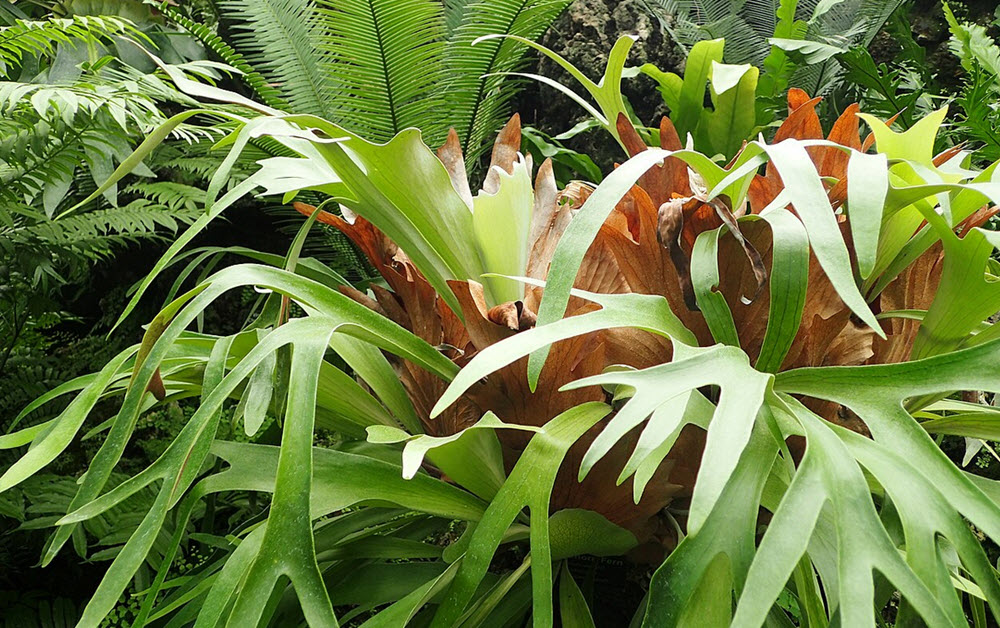Contents
Platycerium bifurcatum, commonly known in English as the Elkhorn Fern or Staghorn Fern, is an epiphytic fern native to tropical and subtropical regions, including Australia, New Guinea, and Java. Its distinctive antler-like fronds make it a popular ornamental plant, ideal for adding an exotic touch to home or garden decor.
Platycerium bifurcatum is a striking and comparatively low-maintenance fern that adds an exotic flair to any plant collection. With proper care, including the right lighting, watering, and occasional feeding, it can thrive and become a centrepiece in your home or garden. Its unique appearance and relatively simple care requirements make it a favourite among plant enthusiasts and beginners alike.

Description
Elkhorn ferns feature two types of fronds:
- Sterile Fronds: These are flat, round, and shield-like or heart-shaped. They help the plant attach to surfaces and offer protection.The sterile fronds can become 10-45 cm long.
- Fertile Fronds: These are long, strap-shaped and bifurcated. They resemble antlers, which is where the plant gets its name. They bear spores for reproduction. The fertile fronds are arching and grey-greenish and can grow up to 90 cm long.
Growing conditions
Light
Elkhorn ferns thrive in bright but indirect light. Direct sunlight can scorch their fronds, so it’s best to place them in a spot where they receive filtered light or partial shade.
Watering
Regular watering is essential, but it’s important to let the plant dry out slightly between waterings.
Misting
Elkhorn Ferns prefer high humidity, so misting them frequently in dry environments is beneficial.
Temperature
The ideal temperature range for Elkhorn ferns is between 60-80°F (15-27°C). They should be protected from colder temperatures, including frost which can damage the fronds and kill the plant.
Care tips
Mounting
Elkhorn Ferns can be mounted on wood or grown in hanging baskets. A mixture of sphagnum moss and bark provides an ideal growing medium, closely mimicking their natural epiphytic conditions.
Feeding
Fertilize monthly during the growing season with a balanced liquid fertilizer diluted to half strength. This helps provide the necessary nutrients for healthy growth and vibrant fronds.
Common issues
Pests
Common pests include scale and mealybugs. Infestations can be treated with insecticidal soap or neem oil. It is important to chose a method that helps to protect the plant without causing harm.
Root rot
Overwatering can lead to root rot, a common issue in Elkhorn Ferns. To prevent this, ensure proper drainage and avoid waterlogging the growing medium.
Tip! Instead of keeping your fern as a potted plant, mimick its natural living conditions and mount it on wood or grow it in a hanging basket. This is more similar to how it would live in the wild and it reduces the risk of root rot. For more information, see the section about mounting above.
Propagation of Elkhorn Fern
Elkhorn Ferns can be propagated through spores or by division. Division is typically the easiest method, involving the separation of offshoots from the main plant to grow new ferns, which will be clones of the mother plant.
Elkhorns in the wild
The native lands for Elkhorn ferns are:
- Java, one of the Greater Sunda Islands in Indonesia
- New Guinea, an island in Melanesia shared by the countries Papua New Guinea and Indonesia
- Australia, where Elkhorn ferns grow in parts of Queensland and New South Wales, including the Lord Howe Island in the Tasman Sea
The Elkhorn fern is a bracket epiphyte that growns in and near rainforests. It can become up to 90 cm tall in the wild and nearly as wide.
Elkhorn ferns can grow in aggregations where various individual plants will specialize for different roles. Near the bottom of such an aggregation, you can find elkhorn ferns that produce sterile fronds, while the strap-shaped reproductive fronds are found higher up. The strap-shaped fronds will collect water and bring it down to the sterile fronds which will absorb it. The strap-shaped fronds will also collect detritus from above to provide the aggregation with nutrients. Both water and nutrients are shared within the aggregation. This type of specialization, coupled with the fact that researchers have found what appears to be overlapping generations within an aggregation, have led experts to suggest that the elkhorn fern might display a type of eusociality.
